List of domesticated plants
This is a list of plants that have been domesticated by humans. The list includes individual plant species identified by their common names as well as larger formal and informal botanical categories which include at least some domesticated individuals. Plants in this list are grouped by the original or primary purpose for which they were domesticated, and subsequently by botanical or culinary categories. Plants with more than one significant human use may be listed in multiple categories.

Plants are considered domesticated when their life cycle, behavior, or appearance has been significantly altered as a result of being under artificial selection by humans for multiple generations (see the main article on domestication for more information). Thousands of distinct plant species have been domesticated throughout human history. Not all modern domesticated plant varieties can be found growing in the wild; many are actually hybrids of two or more naturally occurring species and therefore have no wild counterpart.
Food and cooking
Fruit trees
Pomes
- Apple (Malus domestica)
- Asian pear
- Loquat (Japanese medlar)
- Common medlar
- Pear
- Quince
Other
Numerous other trees have been domesticated for their fruits. There are more than 100 known domesticated plant species native to the Amazon alone.
- Açaí palm (Euterpe oleracea)
- American-oil palm
- Apricot
- Babacu
- Banana (Musa spp.)
- Breadfruit
- Calabash
- Cherry
- Cocopalm
- Durian (Durio spp.)
- Ensete
- Fig
- Ice-cream bean
- Jackfruit
- Mango
- Panama-hat palm
- Papaya (Carica papaya)
- Passionfruit
- Peach and Nectarine
- Peach palm (Bactris gasipaes)
- Plum
- Sapodilla
- Tucuma
Cereals
- Barley
- Finger millet
- Fonio
- Foxtail millet
- Little barley (Hordeum pusillum, central US pre-Columbian)
- Maize (called corn in the U.S.)
- Maygrass (Phalaris caroliniana, central US pre-Columbian)
- Pearl millet
- Proso millet
- Oats
- Rice
- Rye
- Sorghum
- Spelt
- Teff (also tef)
- Triticale (Secalotriticum spp.) – a hybrid between wheat and rye
- Wheat (called corn in the UK, esp. England)
- Bread wheat (Triticum aestivum)
- Pasta or Durum wheat (Triticum durum)
- Einkorn wheat (Triticum monococcum)
Pseudocereals
- Amaranth
- Buckwheat
- Job's tears
- Knotweed bristlegrass (erect knotweed, New World)
- Pitseed goosefoot (Chenopodium berlandieri, central US pre-Columbian)
- Quinoa
- Sunflower (Helianthus annuus)
- Marshelder (sumpweed, Iva annua, central US pre-Columbian)
Legumes
- Beans – eaten dry as pulses or fresh as vegetables
- Azuki bean (Vigna angularis)
- Black-eyed pea (Vigna unguiculata)
- Chickpea (Cicer arietinum)
- Common bean (Phaseolus spp., including pinto bean, kidney bean, runner bean, Lima bean, and others)
- Lentil (Lens culinaris)
- Velvet bean (Mucuna pruriens)
- Mung bean (Vigna radiata)
- Pea (Pisum sativum)
- Peanut (Arachis hypogaea) – botanically a legume, but often referred to as a culinary nut
- Jicama (Pachyrhizus erosus) – the most valuable edible part of the plant is the tuberous root rather than the bean
Sweet small-plant fruits
Aggregated drupelet "berries"
True berries
Other
- Currant
- Grape
- Melon (several species)
- Strawberry
- Avocado
Vegetables

Non-sweet small-plant fruits
- Eggplant (aubergine)
- Peppers
- Squash (e.g., Cucurbita pepo, multiple varieties)
- Tomato
Root vegetables
Herbs and spices
- Allspice
- Basil
- Cinnamon
- Coriander (also called cilantro)
- Cumin (Cuminum cyminum)
- Jasmine (Jasminum spp.)
- Lemongrass (Cymbopogon spp.)
- Nutmeg (Myristica fragrans)
- Oregano (Origanum vulgare)
- Parsley (Petroselinum crispum)
- Peppermint
- Rosemary (Salvia rosmarinus)
- Saffron (Crocus sativus)
- Spearmint
- Thyme (Thymus vulgaris)
- Wintergreen
Commodities
Plants grown principally as animal fodder or for soil enrichment:
Oil-producing plants (for fuel or lubrication):
Utility plants:
- Bottle gourd (used for containers)
Psychoactive plants (for drugs or medicines):
- Belladonna
- Cannabis (Cannabis spp.)
- Chocolate (Theobroma cacao)
- Coffee (Coffea arabica)
- Cola
- Opium poppy (Papaver somniferum)
- Quinine
- Tea (Camellia sinensis)
- Tobacco
Fiber plants (for textiles):
Ornamental plants
References
- Heiser, C. B. (1990). Seed to civilization: the story of food. Harvard University Press, Cambridge, Massachusetts
- Simpson, B.B.; Conner-Ogorzaly, M. (2000). Economic botany: plants in our world. McGraw-Hill Higher Education.
- Vaughan, J. G.; C. A. Geissler (1997). The new Oxford book of food plants. Oxford University Press, Oxford.